

Maker Camp 2015 - Field Trip Friday: NASA SOFIA. Proprioception: Perception & Life Science Activity. Proprioception Wiggle where you're at Even with our eyes closed, we have a sense of body position - where our arms and legs are, for example, and that we are moving them.
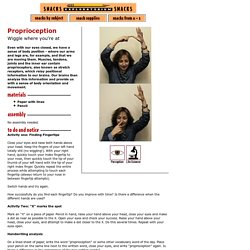
Muscles, tendons, joints and the inner ear contain proprioceptors, also known as stretch receptors, which relay positional information to our brains. Our brains then analyze this information and provide us with a sense of body orientation and movement. Paper with lines Pencil Activity one: Finding Fingertips Close your eyes and raise both hands above your head. Switch hands and try again. How successfully do you find each fingertip? Activity Two: "X" marks the spot Mark an "X" on a piece of paper. Handwriting analysis On a lined sheet of paper, write the word "proprioception" or some other vocabulary word of the day. You are using proprioceptors in your muscles, tendons and joints to judge your body positions in all of these activities. Peripheral Vision: Perception & Life Science Project. Peripheral Vision We are not usually aware of our eyes' limitations.

This Snack is basically a large protractor that lets you test the limits of your peripheral vision. With the help of a friend, you can measure how much you can see out of the corner of your eye. You will find that you can detect motion at a wide angle, colors at a narrow angle, and detailed shapes at a surprisingly narrow angle. Posterboard, cardboard, foamcore, or other stiff material, 1 x 2 feet (30 x 60 cm) . (30 minutes or less) Stick the pushpin, point down, halfway along the 2 foot (60 cm) edge of the posterboard (or whatever board you use as a base). Now stick the pushpin in at the edge of the half-circle, directly across from the nose hole. Use glue to attach the plastic cup to the bottom of the posterboard. Use the marking pens to draw simple shapes (such as rectangles, squares, and triangles), each in a different color, on the faces at one end of the length of wood, or on the file cards.
Bird in the Cage: Color, Light & Perception Science Project. Bird in the Cage Stare at color and see it change.
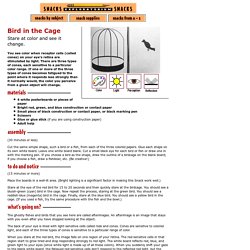
You see color when receptor cells (called cones) on your eye's retina are stimulated by light. There are three types of cones, each sensitive to a particular color range. If one or more of the three types of cones becomes fatigued to the point where it responds less strongly than it normally would, the color you perceive from a given object will change. Benham's Disk: Light, Color & Perception Science Project. Benham's Disk A rotating black-and-white disk produces the illusion of color.
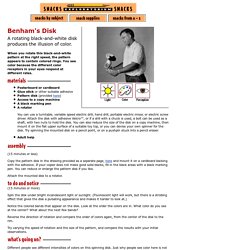
When you rotate this black-and-white pattern at the right speed, the pattern appears to contain colored rings. You see color because the different color receptors in your eyes respond at different rates. Posterboard or cardboard Glue stick or other suitable adhesive Pattern disk (provided here) Access to a copy machine A black marking pen A rotator You can use a turntable, variable speed electric drill, hand drill, portable electric mixer, or electric screw driver. Corner Reflector: Math, Reflection & Light Science Project. Corner Reflector See yourself as others see you.
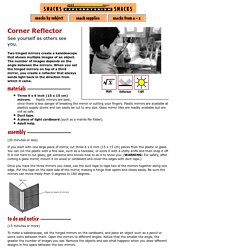
Two hinged mirrors create a kaleidoscope that shows multiple images of an object. The number of images depends on the angle between the mirrors. When you set the hinged mirrors on top of a third mirror, you create a reflector that always sends light back in the direction from which it came. Three 6 x 6 inch (15 x 15 cm) mirrors. Oakland Discovery Center: Zoetrope (mini) Materials: • 4.5” dia. clear plastic round deli container, 16 oz. • large chopstick • straws (must big enough to fit the chopstick, we used “jumbo” straws) • electrical tape • 2.25” dia. foam core washer • 10.5”x 1” paper animation strip (with frame lines every 1.25” pre drawn)

Easy Kaleidoscope. This kaleidoscope is easy to make and kid friendly since it doesn't involved any sharp (or expensive) materials like mirror pieces.
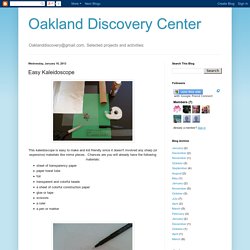
Chances are you will already have the following materials: DIY Kaleidoscopes. Pin It My kids have been asking to make kaleidoscopes for years—and I mean years!
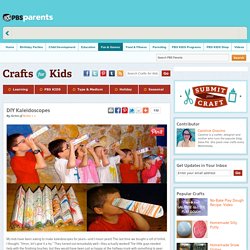
The last time we bought a roll of tinfoil, I thought, “Hmm, let’s give it a try.” They turned out remarkably well—they actually worked! The little guys needed help with the finishing touches, but they would have been just as happy at the halfway mark with something to peer through. Kaleidoscope Science. Please ensure you have JavaScript enabled in your browser.
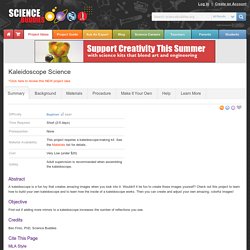
If you leave JavaScript disabled, you will only access a portion of the content we are providing. <a href="/science-fair-projects/javascript_help.php">Here's how. Kids Crafts & Activities for Children. Peter Hudson Design : Zoetrope Artist. HTKscopeFNL.